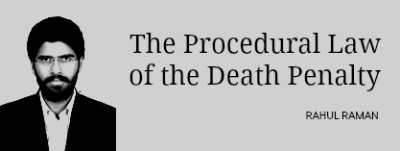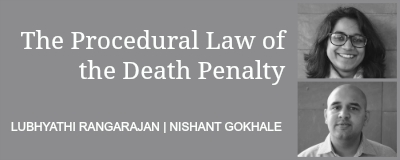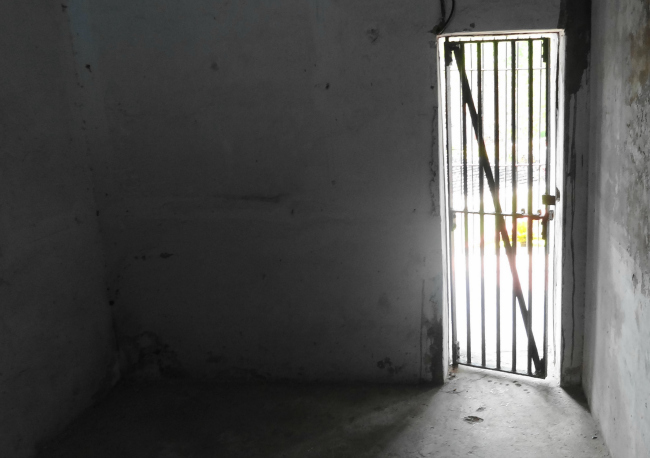 If the situation that prevailed at the time a sentence of death was delivered has changed, can the Supreme Court take those changed circumstances into account to commute a sentence of death? Less than two years ago, the Supreme Court in Shatrughan Chauhan v. Union of India, 2014 (3) SCC 1, looked into whether executing a death sentence notwithstanding the existence of such supervening circumstances would violate among other things, Article 21 of the Constitution. After weighing such circumstances in different petitions, it commuted the penalty of fifteen individuals to life imprisonment and laid down a more definitive law on the Court’s power of commutation.
If the situation that prevailed at the time a sentence of death was delivered has changed, can the Supreme Court take those changed circumstances into account to commute a sentence of death? Less than two years ago, the Supreme Court in Shatrughan Chauhan v. Union of India, 2014 (3) SCC 1, looked into whether executing a death sentence notwithstanding the existence of such supervening circumstances would violate among other things, Article 21 of the Constitution. After weighing such circumstances in different petitions, it commuted the penalty of fifteen individuals to life imprisonment and laid down a more definitive law on the Court’s power of commutation.
The petitioners had claimed that the executive, while exercising its power under Articles 72 or 161, did not consider any supervening events. In a few previous decisions such as Triveniben (1989) and Jagdish v. State of Madhya Pradesh (2009), the Court had declared that it had a duty to protect a prisoner’s right to life till his last breath. This provided the Supreme Court with the legal basis to take supervening circumstances into consideration and those pleaded in Shatrughan Chauhan included delay, insanity, solitary confinement, and procedural lapses.
Delay in processing mercy petitions
The question of whether the executive’s delay in processing a mercy petition should be considered a supervening circumstance has troubled the Court for a long time. There is no stipulated time limit within which the executive has to dispose a mercy petition and often, there is inordinate delay.
Earlier, a division bench of the Supreme Court in T.V. Vatheeswaran v. State of Tamil Nadu, AIR 1983 SC 361, had held that a delay of two years in execution of a sentence after the judgment of the trial court would entitle the prisoner to plead for commutation of his sentence of death to life imprisonment. Soon after however, a three-judge bench in Sher Singh and Others v. Union of India, AIR 1983 SC 465, held that delay alone could not be a good enough ground for commutation of death sentence, and overruled the two-year delay rule. Nevertheless, this decision acknowledged a prisoner’s right to a fair procedure at all stages – trial, sentencing, and incarceration.
To resolve this apparent conflict, a constitution bench took up this issue in Triveniben v. State of Gujrat, 1988 (4) SCC 574. In a landmark verdict, the Court held that while an undue delay would entitle a punished individual to invoke Article 32, Vatheeswaran’s “two-year delay rule” was not correct.
The Court relied on this decision in Shatrughan Chauhan. It held that while considering the rejection of a clemency petition, the Court could not overlook the pain caused to the convict. Therefore, the Court was well within its judicial power under Article 21 read with Article 32 of the Constitution to hear a convict’s grievance and commute a death sentence to life imprisonment if it is found that that there had been undue, unexplained, and inordinate delay in execution due to the pendency of a mercy petition.
The Court decided not to lay down any compulsory period within which the President has to decide a mercy petition. While the Court would make such a determination on the facts and circumstances of individual cases, it suggested that the executive should itself weigh the aspect of delay while disposing of a mercy petition.
The Court also said that the decision of the Court in Devender Pal Singh Bhullar v. State (NCT) of Delhi, 2013 (6) SCC 195, which had disqualified cases under the Terrorist and Disruptive Activities (Prevention) Act, 1987 from scrutiny on account of delay, was per incuriam. Any person sentenced to death could avail “delay” as a supervening circumstance regardless of the offence and the statute under which he has been convicted. Later, the Supreme Court recognised this finding in Navneet Kaur v. State of NCT of Delhi, Curative Petition (Criminal) No. 88 of 2013 (Supreme Court) to commute Devender Pal Singh Bhullar’s death sentence to life imprisonment.
Insanity or mental illness
The next ground considered by the Court was that of “insanity” or “mental illness” as a supervening circumstance. The Court after referring to several international conventions like the International Covenant on Civil and Political Rights concluded that this was a valid supervening circumstance. It noted that once mental illness of the convicted individual is medically certified, executing him would be in violation of the international convention to which India was a party, and of Article 21 of the Constitution.
Solitary confinement
Despite underlining its own finding in Sunil Batra v. Delhi Administration and Others, 1978(4) SCC 494, the Supreme Court decided not to interfere on the ground of “solitary confinement” in Shatrughan Chauhan. Later however, the Allahabad High Court in People’s Union for Democratic Rights v. Union of India, 2015(2) ADJ 2015 and the Supreme Court in Ajay Kumar Pal v. Union of India, 2014(13) SCALE 762 held that “solitary confinement”, along with other factors, was a permissible supervening circumstance to commute death sentence to life imprisonment.
Procedural lapses
The final ground raised was that of “procedural lapses” made by the executive while disposing of mercy petitions. The Court held that the procedures prescribed for the Ministry of Home Affairs were a necessary requirement under Article 21 to treat the death row convicts fairly. It noted that the President should be provided with all the relevant material to assist him in disposing the mercy petitions. The concerned departments cannot give or seek piecemeal information regarding the petition to be decided. However, the scrutiny of a procedural anomaly would be done on a case-to-case basis.
The circumstances raised in Shatrughan Chauhan are not exhaustive. The addition (or removal) of supervening circumstances to this list would depend on the judicial attitudes to reconciling convict’s rights with those of the victim or the society. Further, despite the unambiguous decisions in Triveniben and Shatrughan Chauhan, it is entirely up to the Court to see on an individual basis, how to interpret ‘undue and unexplained’ delay and whether to permit it as a supervening circumstance.
(Rahul Raman is a Project Associate at the Centre on the Death Penalty, National Law University, Delhi.)








